Yew berry: description, best varieties, planting and care rules

Berry yew is a coniferous tree that can become a real decoration of the garden. It is characterized by slow growth, excellent decorative properties, and in the autumn period its branches are covered with seeds of a bright red-orange color.
The plant belongs to the relict group and in its natural habitats is gradually exterminated, not without human participation. It should be noted that in the conditions of garden cultivation, the most often used form of vegetative propagation, in which the yew takes the form of a bush.

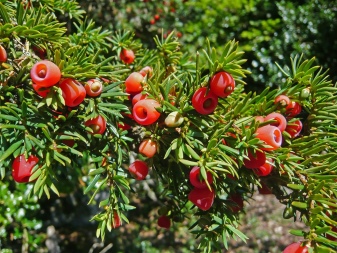
Description
Mature plants are a very valuable source of wood - this very "mahogany", considered one of the most expensive and luxurious materials for the manufacture of furniture and interior items. But the fruits and other parts of the plant are poisonous and require rather careful handling.
That's why yew berry is a rare guest in gardens, and the care and planting of this tree often remains an unexplored area for ordinary summer residents... And this is a big omission, because the plant is very undemanding and takes root well. To be convinced of this, it is worth studying in more detail the description of the yew "Repandens", "Elegantissima", "Fastigiata Robusta" and other varieties.
Coniferous tree or yew berry shrub belongs to evergreen plants of the north of Europe and Africa, found in Asia, North America. It does not grow too quickly, branches abundantly, and is suitable for cutting the crown, which is important for gardens where the correct geometry of the forms of plants is required. Winter-hardy varieties in the country or in the local area are suitable for the formation of hedges.


The lifespan of this relict tree is impressive. It can be 1500-4000 years old, the oldest of the currently existing berry yews - Fortinghalle - is located in Scotland. According to scientists, it is 2000-5000 years old. The height of an adult tree rarely exceeds 20 m, but specimens up to 40 m in height are known.
Yews often form mixed groves with boxwoods or form forests without other species. Yew can be found in the North Caucasus, the Kuriles, in the Crimea and other regions with a mild coastal climate. In the conditions of central Russia, the tree requires mandatory shelter in the winter, with the exception of winter-hardy Canadian and North American varieties.


The average diameter of the trunk of the yew berry reaches 1.5 m, the crown is branched, dense, the formation of several peaks is often observed. The bark has a gray-burgundy or gray-pink hue, lamellar or smooth, depending on age, structure.
On the surface of the trunk, the presence of abundantly forming buds is noted, from which lateral shoots later depart. The needles are elongated, soft, wide, reaching 25-35 cm. Seeds in garden subspecies first appear in the 30th year of life, in nature later, upon reaching 70 years.



Review of popular varieties
Berry yew has about 150 varieties, including wild and cultivated in botanical gardens or arboretums. For a suburban or suburban area, the following varieties are considered most preferable.


"Fastigiata robusta"
Columnar variety with a dense crown and branchy shoots adjacent to the trunk. The needles are small, dark green in color, reaching a length of 2-2.5 cm.The growth rate per year is 5-8 cm, by the age of 10 the tree reaches from 100 to 200 cm, but more often it remains rather short. The crown lends itself well to pruning, can be used as a basis for creating green sculptures.


"Repundance"
A low-growing shrub variety, reaching no more than 0.5 m in height, with a wide creeping crown. The needles of this berry yew are colored quite brightly, in a blue-green tone, and have a bluish tint.
The variety is very popular in landscape design, it is widely used in the arrangement of rock gardens, in the creation of mixborders and for decorating the area around artificial ponds.


"David"
A light-loving bush variety with optimal characteristics for the middle lane. It is hardy and does not need shelter. The variety is recommended for planting in sunny areas to preserve the yellow color of the needles. In the shade, the needles take on a bright light green hue.
Berry yew "David" is suitable for creating original patterns or curly haircuts.


"Elegantissima"
A shrub undersized variety with abundant branching, reaches no more than 1 m in height, the crown can be up to 1.5 m in diameter. A feature of the Elegantissima berry yew is the unusual color of the needles - it is light yellow, close to cream, it can change depending on the illumination of the site. The variety is drought-resistant due to its developed root system. In the conditions of central Russia, "Elegantissima" rarely grows more than 0.5 m due to too cold climatic conditions.

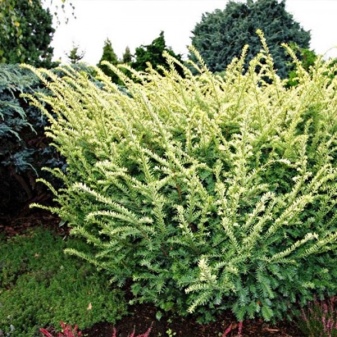
Summergold
This variety is distinguished by the rich golden color of the needles, for which it got its name. The crown is cushion-shaped, the bush grows rather slowly, by the age of 10 it reaches 80 cm. Among the disadvantages of the variety is its high demand for moisture. But it is frost-hardy, suitable for growing in central Russia, very decorative and looks good as part of park and flower alleys.


"Semperaurea"
A shrub variety with a decorative lush crown. In the warm season, the needles have a rich golden hue, and in the cold they become more orange. It grows fast enough for berry yews - for adults it reaches 3-4 m in height and up to 5 m in diameter, lends itself well to trimming and shaping.
The shrub is shade-tolerant, does not like direct sunlight, is sensitive to crown burns.
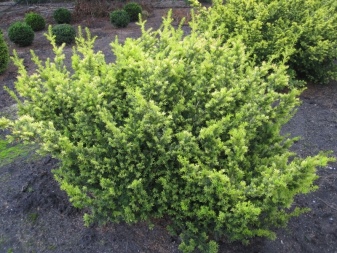

Cooper Gold
Shrub variety with a lush spherical crown and pale yellow needles. The height of an adult plant does not exceed 1 m, it is winter-hardy, suitable for use in hedges, looks good in a rock garden.

"Green rocket"
A tree with a columnar crown and branches tightly attached to the trunk. It grows up to 4-5 m with a diameter of no more than 1 m, needle-type needles, bright green. The plant goes well with hedges, suitable for the formation of complex architectural forms in the landscape of the site.


Landing features
Berry yew is relatively unpretentious and suitable for growing in different climatic conditions. But transplanting it from a container is not recommended in acidic or swampy soil, excessively dry soil, or in places with strong winds. The optimal solution would be to choose a sunny, well-lit area, but in this case, the frost resistance of the tree will be noticeably reduced. When planting in light, but shaded places, it is possible to maintain the brightness of the needles, to achieve abundant fruit formation.
The correct soil for berry yew is moist, well fertilized with nutrients. The best choice is the use of clay or limestone soil.
If there is a reservoir, it is better to place the plant closer to it. This will save the needles from losing brightness, and the tree or bush from drying out. In winter, it is better to provide the plant with additional shelter from frost and wind.
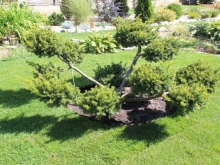


Before planting the berry yew, it is worth carefully loosen the existing soil layer in advance, to provide it with the necessary saturation with nutrients. For this, a mixture of 2 parts of peat and sand with 3 parts of turf is used. With a close occurrence of groundwater, good drainage is sure to be arranged. Stagnation of water is unacceptable, it will simply destroy the root system.
When choosing a seedling, preference should be given to those specimens that correspond to the color of the needles and trunk to their botanical description. In the pot, there should be no plaque on the soil, on the bark - spots, cracks, and other damage.
Landing is carried out in the spring, after the snow melts and the groundwater level drops. It is important that the soil has time to warm up enough. If several plants are planted, a distance of at least 0.5-3 m is maintained between them, depending on the variety, the estimated parameters of an adult tree or bush. A closer planting is possible for a hedge.
The preparation of the planting pit requires the creation of a 60-80 cm depression, a mixture of fertile soil, peat and sand, harvested earlier, is laid inside, the addition of complex fertilizer for conifers is allowed. The seedling is freed from the container, placed in the ground so that the root collar is above the level of the upper sod layer, the remaining soil is poured, compacted and watered. The surface at the planting site is mulched with peat or sawdust.
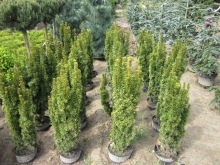
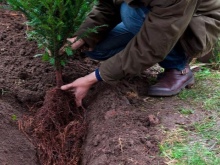

Care rules
In order for the berry yew to grow and develop correctly, it needs full care. It includes the following procedures.
- Watering. It should be regular for the first 24 months after planting. But it is always worth focusing exclusively on weather and climatic conditions. In dry periods, 10-12 liters of water are added monthly under a bush or root of a tree, and the crown is sprinkled every 14 days. This is not required during high rainfall seasons.
- Top dressing. It is carried out at planting, in the proportion of 1 g of nitroammophoska and 15 mg of copper sulfate per 1 liter of water, fertilization is repeated a year later. During the active growing season, the plant is additionally fed with Florovit preparations and their analogues.
- Pruning. Divided decorative haircut for crown formation and sanitization. The first is carried out 3-4 years after planting, after the branches have grown quite luxuriantly. Sanitary pruning is performed once a season, in March or April, removing dried and dead branches after wintering.
- Preparing for winter. In winter, you cannot do without additional shelter for the seedling. Among the shrubs, there are more winter-hardy species, they are usually simply sprinkled at the roots with a layer of peat 6-7 cm thick. In young plants with a lush crown, branches are tied in a bunch for the winter. Adult specimens do without shelter.



Reproduction methods
Propagation of berry yew, like most conifers, is possible by seeds or through cuttings. In nature, the tree reproduces in the first way. But this method is too complicated for home use. Seeds can germinate for years, and germination lasts about 4 years. Difficulties can arise with the choice of a tree for reproduction.
This is a dioecious plant, so you need to make sure that there are both male and female bushes on the site.



Reproduction by cuttings is much easier and more efficient. Shoots of 1 and 2 years are suitable for rooting; when cut in the upper part, the new plant will be more elongated. To obtain a spreading bush, the cutting is cut from a horizontally located branch. Shoots are cut in the autumn, the lower part of the planting material is freed from needles, and then placed in a seedling box under a film.
The growing substrate is made up of 1 part sand and 2 peat. Rooting of seedlings by cuttings occurs in 90 days. In the spring they are ready to be transplanted into separate pots.Young berry yews are transferred to open ground at the end of spring.



Diseases and pests
What diseases and pests threaten the berry yew during the period of its growth and development? Among the most common misfortunes are the following.
- Yellowing of the needles. If we are not talking about forms in which the needles should have a straw tint, the reason may be the natural dying off of a part of the cover. The needles often turn yellow and dry in the sun if the bush is young. It is better to shade the plant from spring burns in the daytime.
- Fomoz. Fungal disease, manifested by necrosis of the bark, browning and drying of the needles (at first it turns yellow). The infection is quite persistent, does not die during the winter. The fruiting bodies of the fungus gradually break through the bark, look like small black growths. The dried tissue of the tree has to be completely removed, prevention and treatment consists in spraying with a 1% solution of Bordeaux mixture in the spring and autumn.
- Black. A fungal disease characterized by the formation of a black soot-like film on the shoots and needles of the plant. As a rule, the mob accompanies the appearance of a false shield on a tree or bush. First, you will have to remove the main parasite, the young plant can be transplanted to a more illuminated part of the territory, thinned out to improve air exchange. Copper spraying can be used.
- Yew gall midge. This parasite affects the appearance of the plant, greatly impairing it. A sign of the appearance is the shortening of the needles at the ends of the shoots, collecting them in bunches. Inside such a neoplasm, you can find a fly larva, a yew gall midge, which has a reddish color. The fight is carried out by spraying the plant with a solution of special preparations, "Enzhio 247 SC" will do at a concentration of 3.6 ml per 10 liters of water.
- Yew false shield. Flying parasitic insects that lay eggs under their bodies. The larvae that appear in the middle of summer, which populate the lower tier of branches and damage the needles, are dangerous for the tree. The cover turns black, crumbles, a fungus appears on the waste products of the pest. Preparations for pest control are selected individually, spraying is carried out in the first decade of July, repeated after 2 weeks.
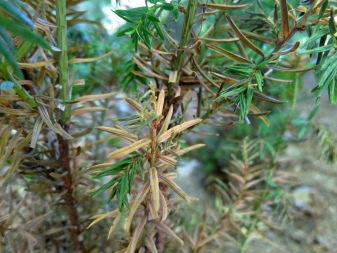

Use in landscape design
The use of berry yew in landscape design is quite wide. With its help, a decorative hedge can be created, equally attractive in summer and winter. Shrub shapes tolerate pruning and shaping well, can be used to create shapes – from balls to cubes or columns.
Without pruning, compact varieties also do not disintegrate, they have a neat appearance - in this case, it is better to initially choose options with a small rounded or cushion-shaped crown.



Decorative ephedra - berry yew - looks good in the frame of reservoirs, garden paths, it is actively used in topiary gardens, rock gardens. This look blends harmoniously with sculptures. In group plantings, it can set off mixborders. As neighbors for yew, it is better to choose other conifers with a different type of needles - junipers or thuja. In addition, you can create interesting compositions with rhododendrons and ferns.


The following video will tell you about the berry yew and its varieties.






























































The comment was sent successfully.